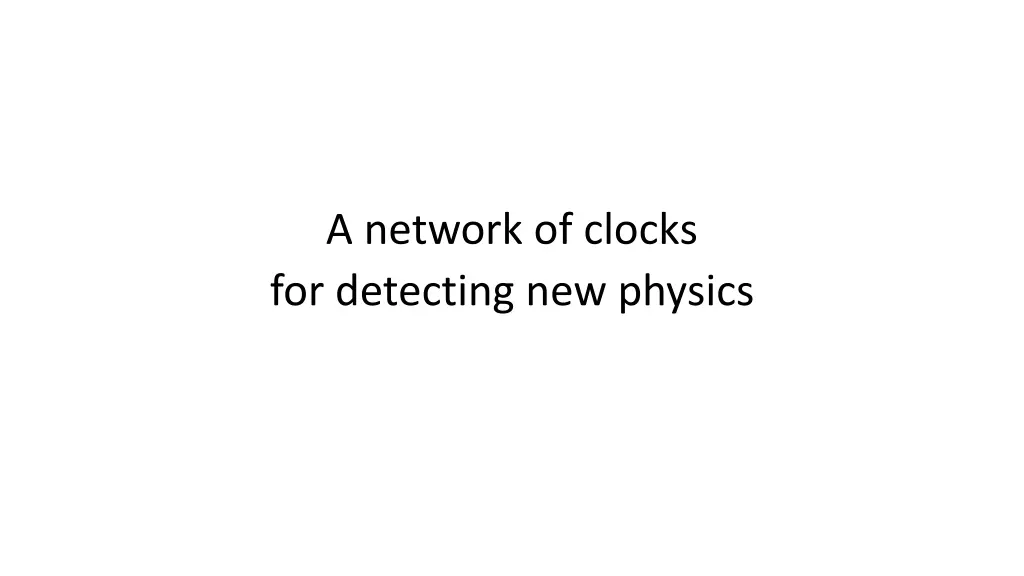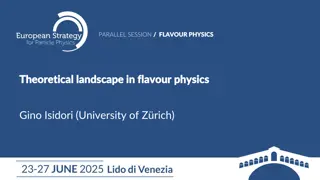
Clocks for Detecting New Physics
Explore a network of optical clocks with high sensitivities to variations in fundamental constants for detecting new physics. The project involves developing optical clocks, expanding research networks, measuring frequency ratios, and searching for variations in fundamental constants to test various dark matter and energy models, quantum gravity, and grand unification theories.
Download Presentation

Please find below an Image/Link to download the presentation.
The content on the website is provided AS IS for your information and personal use only. It may not be sold, licensed, or shared on other websites without obtaining consent from the author. If you encounter any issues during the download, it is possible that the publisher has removed the file from their server.
You are allowed to download the files provided on this website for personal or commercial use, subject to the condition that they are used lawfully. All files are the property of their respective owners.
The content on the website is provided AS IS for your information and personal use only. It may not be sold, licensed, or shared on other websites without obtaining consent from the author.
E N D
Presentation Transcript
A network of clocks for detecting new physics
Key technical deliverables: 1. Develop optical clocks (based on neutral atoms, ions, highly charged ions, molecules and nuclei) with high sensitivities to variations in fundamental constants such as the fine structure constant and the electron-to-proton mass ratio 2. Maintain and expand national and international research networks of optical fibres across Europe, connecting optical clocks in different countries 3. Measure the ratio of frequencies from different pairs of optical clocks across Europe, at the 10-18level and beyond Key physics deliverables: 1. Look for variations in fundamental constants such as the fine structure constant and the electron-to-proton mass ratio , which could be used to test Ultralight dark matter models Quintessence-like models of dark energy Generic hidden sector scalar fields Kaluza-Klein models Dilaton field models Soliton models Transient phenomena due to cosmic strings, domain walls, and kinks of a scalar field Look for violations of Lorentz Invariance and Local Position Invariance Perform tests of quantum gravity Test grand unification theories Detect transient events linked to macroscopic dark objects, such as topological defects, Q-balls and dark stars 2. 3. 4. 5. 2
Datasets and running/exposure time required for the numbers above: approximately 10 years Environmental cost of construction (in units of tonnes of CO2 equivalent): not known Environmental cost of operation per year (in units of tonnes of CO2 equivalent): not known Estimate of financial costs (provide separate numbers for R+D phase, construction phase and operations phase): R&D phase, building ~10 exotic clocks: 50M Construction phase, setting up new European and national links: 25M Operations phase, running the network of clock, perform comparisons and analysing data: 25M Does your project plan dedicated submission(s) for the ESPPU (if so, give details): no Comparison of physics goals with the current state of the art in the area: Clocks cover several orders of magnitude in scalar dark sector masses [arXiv:2203.14915v1] At least one orders of magnitude improvement in sensitivity with respect to the state-of-the-art [arXiv:2203.14915v1, EPJ QT 9, 12 (2022)] 3
List the project's main advantages compared to competitor projects: Optimal exploitation of resources and expertise spread across different institutes. Remote clock comparison technique is already quite mature compared to other methods. Geographic advantage in Europe high density of optical clocks that can be linked via terrestrial fibres. Project can be easily scaled up/down by adding more/fewer clocks into the network Networks enable probing of space-time correlations, providing added information, such as the speed and directionality of the oscillating dark sector fields Networking is the only possibility of detecting transient events linked to macroscopic dark objects, such as topological defects, solitons, Q-balls and dark stars Having N pairs of clocks within the coherence length of oscillating dark-sector fields can improve the limit from a single pair of clocks by a factor sqrt(N) Preferred location for the project: diffuse network across Europe Project timeline (if possible provide separate by the R&D, construction and exploitation periods) R&D (development of exotic clocks) 5 years Construction (building the fibre network) 5 years Exploitation: first measurement campaign 5 year Main risks/obstacles for realisation of physics goals: Technical risks in achieving the level of measurement improvements and scale of network Anticipated area(s) of UK involvement: QSNET project clocks at Birmingham, Imperial, Sussex, NPL, theory expertise at Sussex, fibre link expertise Total number of FTE /year required for construction/operation: R&D 50 FTE/year for 10 clocks, construction 20 FTE/year, Exploitation 60 FTE/year What is the expected UK FTE? R&D 25 FTE/year for 5 clocks, construction 2 FTE/year, Exploitation 35 FTE/year 4

